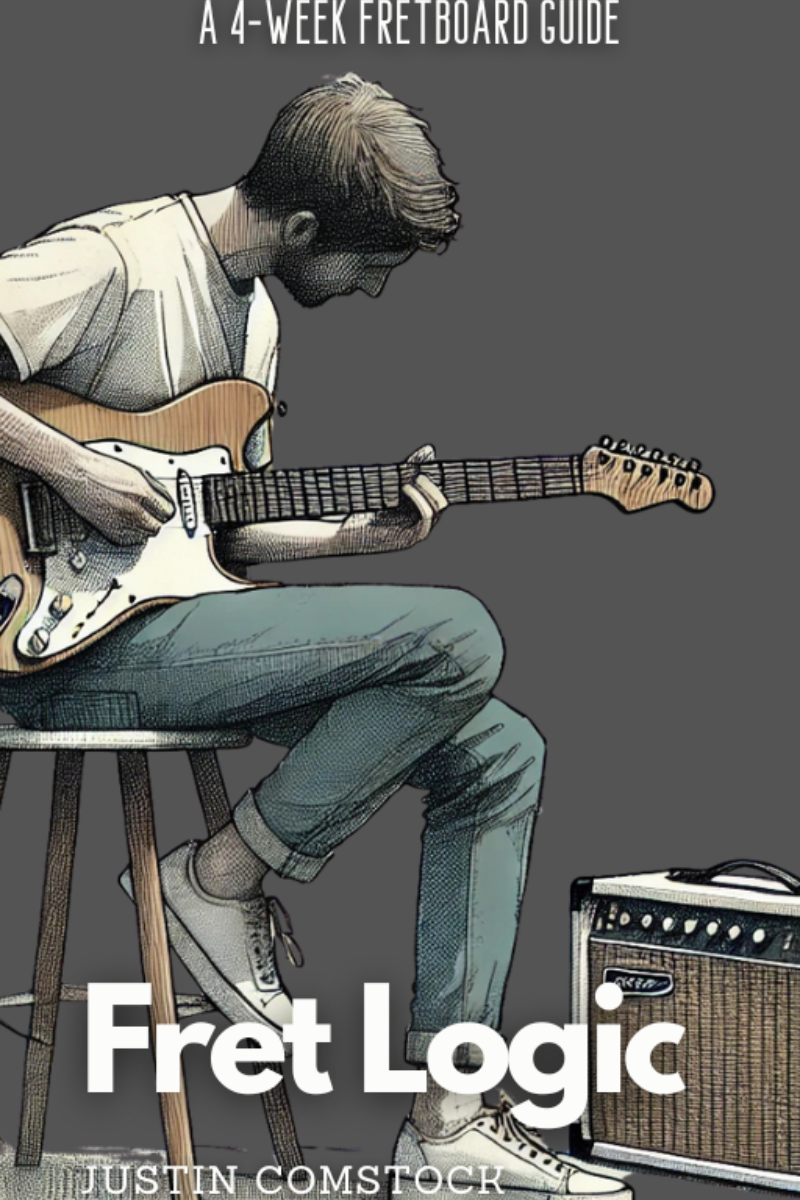Most guitarists start with the sunny side of the fretboard: major chords. They’re safe. Familiar. Easy to hum along to.
But let me tell you—the real magic lives in the shadows.
If major chords are daylight, minor chords are dusk—mysterious, moody, and infinitely rich in emotional color. They don’t just change the song; they change you as a player.
In this article, I’ll walk you through:
- How minor chords guitar work (without getting lost in theory),
- 3 timeless minor chord progressions you need to know,
- Iconic songs that showcase the emotional weight of minor harmony,
- And a real student story—Jack—who went from “happy strummer” to “melodic storyteller” once he embraced minor chords.
And if you’re ready to go deeper into expressive playing, don’t miss my FretDeck Kickstarter—a practice system that helps you master chords, triads, scales, and storytelling on the guitar. 🎯

❌ Stop Guessing. Start Shredding.
If you’re still fumbling through scale patterns and box shapes… it’s costing you progress.
FretDeck™ is the no-fluff system that shows you exactly how to master the fretboard—fast. Early access.
⚡️ This isn’t for dabblers. It’s for players who want results.
👉 Click here to join the pre-launch now
Early access. Limited rewards. Don’t wait.
🎼 The Emotional Language of Minor Chords Guitar
Here’s what most theory books won’t tell you:
Minor chords are less about being “sad” and more about expressing tension, soul, vulnerability, longing, and cinematic resolution.
At their core, minor chords are built from:
- Root
- Minor third
- Perfect fifth
That lowered third—that’s the heartbeat. That’s the part that grabs you by the collar and pulls you into a story.
✍️ Most Common Minor Chords Guitar:
- A minor (Am) – open chord, melancholic and classical
- E minor (Em) – dark and brooding, an open string powerhouse
- D minor (Dm) – whispery and introspective
- C minor (Cm) – powerful barre chord used in soulful solos
- G minor (Gm) – jazzy, funky, or gothic depending on context
🔄 3 Minor Chord Progressions That Change Everything
1. i – iv – v (A Minor: Am – Dm – Em)
Used in:
🎵 “House of the Rising Sun” – The Animals
The way this progression breathes tension and release is classic. Play it slow. Feel the weight of each chord. It doesn’t just set a mood—it haunts.
🧠 FretDeck Tip: Use your minor pentatonic licks over this to start developing your ear for melody in minor contexts.
2. i – VI – VII (E Minor: Em – C – D)
Used in:
🎵 “Losing My Religion” – R.E.M.
This one tugs on your emotions while offering hope. It’s introspective, but not hopeless. R.E.M. nailed that sweet-spot tension—something’s unresolved, and that’s why it works.
🎯 CTA: Want to unlock this sound and solo over it? My FretDeck cards show you exactly where to play inside this progression—without guesswork.
3. i – iv – VII – III – VI – ii° – V (A Minor Jazz: Am – Dm – G – C – F – Bm7b5 – E)
Used in:
🎵 “Autumn Leaves” – Jazz Standard
This is what happens when harmony becomes poetry. The chords walk. They tell a story. Jazz players love it, but even if you’re a rock guitarist, you’ll find gold in these changes.
🧠 Discord Tip: Share your voicings of this in the Guitar Freaks Hangout—get feedback and see how others are navigating this lush progression.
🎸 Songs That Let Minor Chords Shine
Let’s ground this in music. These classics use minor chords not as seasoning—but as the main course.
✅ “Black Magic Woman” – Fleetwood Mac / Santana
Chords: Dm – Am – Gm – Dm – E7
Sultry. Swirling. Santana’s version builds a hypnotic storm from these simple changes.
✅ “Stairway to Heaven” – Led Zeppelin
Chords: Am – G#aug – C – D – F – G – Am
Mystical, layered, iconic. If there’s one minor progression that taught generations of guitarists the power of dynamics and space—this is it.
✅ “Hotel California” – Eagles
Chords: Bm – F# – A – E – G – D – Em – F#
It’s smooth. Slick. With a touch of dread. And those minor changes set the perfect cinematic vibe.
🎧 Want to practice along? Drop these chords into a looper, then experiment with A minor and B minor pentatonic licks.
🎓 Jack’s Journey: From Major-Only to Minor-Storyteller
Let me tell you about Jack.
Jack came to me knowing his open chords and a few licks. He could strum “Sweet Home Alabama” with ease—but every song felt the same.
He said:
“I want to feel something when I play. Not just play the right chords.”
So we started with Am. He loved it—because it sounded real.
We moved to “House of the Rising Sun.” His eyes lit up.
“It’s like the guitar is saying something…”
Soon Jack was learning “Autumn Leaves”—struggling with Bm7b5 at first, but getting hooked on the sound.
The real breakthrough?
Improvising over minor chord progressions. He used the A minor pentatonic scale like a paintbrush. His solos had breath. Movement. Pain. Beauty.
Today, Jack plays “Stairway to Heaven” like a film score. And every note counts.
🛠️ Practice Prompts: Mastering Minor Chords Guitar
Use these daily to deepen your minor chord vocabulary:
- 🎯 Transition Drill: Practice switching from Am to Em to Dm with a metronome. Aim for clarity over speed.
- 🎯 Alternate Voicings: Play Em in open position, barre, and triad form across the neck. Hear how the same chord can wear different outfits.
- 🎯 Minor to Major Shifts: Practice progressions like Am – C – G – F and notice the emotional shifts.
- 🎯 Improv Layer: Loop a minor progression and solo using the minor pentatonic and natural minor scales. Phrase with intent.
- 🎯 Chord Connection Game (FretDeck Prompt): Pull a card. Play the chord in three positions. Then create a 3-chord progression with it.
💬 Join the Community: Guitar Freaks Hangout 🎸
Inside our free Discord:
- Get weekly minor chord prompts
- Share your solos and chord voicings
- Ask questions, post clips, and get feedback from other guitar freaks like you
👉 Join the Hangout Here →

Join Guitar Freaks Hangout on Discord! 🎸
Get Fret Logic FREE!
Join the Guitar Freaks Hangout Discord and get exclusive access to my entire e-book, Fret Logic! Master the fretboard and elevate your solos with this comprehensive guide.
👉 Don’t miss out—join now and download your free copy!
🎁 Back the FretDeck Kickstarter Now
If you’re serious about mastering minor chords—and every other piece of the fretboard puzzle—then FretDeck is your next move.
It’s a deck of cards that trains your brain to:
- Learn chord shapes, notes, and progressions
- Visualize scales and modes
- Get creative with practice, not bored
⏳ Only a few early-bird spots left. Back now and get instant access to bonus PDFs + Discord prompts.
👉 Back the FretDeck Kickstarter Now

❌ Stop Guessing. Start Shredding.
If you’re still fumbling through scale patterns and box shapes… it’s costing you progress.
FretDeck™ is the no-fluff system that shows you exactly how to master the fretboard—fast. Early access.
⚡️ This isn’t for dabblers. It’s for players who want results.
👉 Click here to join the pre-launch now
Early access. Limited rewards. Don’t wait.
🧭 What’s Next?
🎸 Want to explore how minor scales interact with these chords?
Check out our in-depth guide on the minor pentatonic guitar scale and learn how to solo with emotion in every key.
A comprehensive lesson on how minor chords relate to scales:










